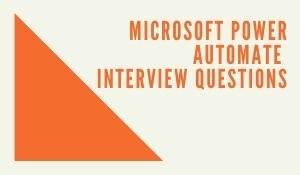
1.
What is Microsoft Flow?
Microsoft Flow / Power Automate is a cloud-based
service from Microsoft which can be used to create workflows in order to
automate lengthy manual tasks.
2.
What is Power Automate?
Power Automate is a cloud-based service that makes
it practical and simple for line-of-business users to build workflows that
automate time-consuming business tasks and processes across applications and
services.
3.
What is Microsoft Power automate used for?
Power Automate is a service that helps you create
automated workflows between your favorite apps and services to synchronize
files, get notifications, collect data, and more.
4.
Who is the intended audience for Power Automate?
Power Automate has two distinct audiences:
- Line-of-business “Citizen Integrators”
in enterprise organizations who partner with IT to move responsibility for
business solutions closer to the business itself. - IT decision makers who want to empower
line-of-business partners to create their own solutions so IT professionals and
integration specialists can focus their expertise on more advanced integration
tools, such as Azure Logic Apps.
5.
How do Power Automate and Logic Apps relate to each other?
Power Automate provides features that help
line-of-business users create automated workflows. Logic Apps is an Azure
service that provides the same great features of Power Automate, plus features
such as integration with Azure Resource Manager and the Azure Portal,
PowerShell and xPlat CLI, Visual Studio, and additional connectors. Learn more
about Logic Apps.
6.
How does Power Automate fit in Microsoft’s overall business application
platform strategy?
Power Automate is part of a powerful and adaptable
business application platform that includes Power Apps, Common Data Service,
Dynamics 365, and Office 365. This platform allows our customers, our partners,
and our ISV partners to create purpose-built solutions for their own companies,
their industry, for functional roles or even for specific geographies.
Line-of-business users, who understand their business needs best, can now
easily analyze, compose, and streamline data and processes. Professional
developers can easily extend the automation, analytics and apps
line-of-business to leverage Azure services like Functions, App Service, and Logic
Apps. API connectors, gateways, and Common Data Service make it possible to get
more value out of services or data already in use, either in the cloud or
on-premises.
7.
What do I need to use Power Automate?
To use Power Automate, all you need is a web browser
and an email address.
8.
Which email addresses are supported?
Power Automate supports email addresses that end
with anything except .gov and .mil.
9.
Is Power Automate available on-premises?
Power Automate is a public cloud service only.
However, you can securely connect to your own on-premises services through the
on-premises data gateway.
10.
What services can Power Automate connect to?
Power Automate connects to more than 100 data
sources out of the box, and we’re adding more all the time. Some examples of
data sources and services include the following:
- SharePoint
- Dynamics 365
- OneDrive
- OneDrive for Business
- Google Drive
- Google Sheets
- Trello
- Box
- SalesForce.com
- Mailchimp
- Customer APIs

11. What are templates?
Templates are pre-built flows for popular and common
scenarios. Using a template only requires you to have access to the services in
the template and to fill out any required settings.
12.
What data sources will I be able to connect to?
You can connect to more than 100 standard services
from Microsoft and third parties, such Office 365, Twitter, SharePoint,
OneDrive, Dropbox, SQL Server, and more. You can also connect to premium
services such as Salesforce and Common Data Service.
13.
How do I connect to a REST API in my flow?
You can connect to any REST API that uses JSON and
supports at least one of more than 10 authentication methods by creating a
custom connector.
14.
Can I share the flows I create?
You can share flows in either of these ways:
- You can add co-workers or groups in your
organization as owners on your flows, so they can also edit and manage the
flow. - For flows that can be run manually, you
can also grant other people or groups in your organization permission to just
run the flow.
15.
Can Flows be turned off or disabled?
Yes, each flow has an on/off switch that enables you
to stop the flow from processing requests.
16.
How does Power Automate compare to SharePoint Designer 2013?
Power Automate is the successor to SharePoint
Designer for many common business scenarios such as approvals, document review,
and on boarding/off boarding. It will be the default tool for building business
automation in SharePoint moving forward.
17.
Does Power Automate support service accounts?
While you can create flows with a service account,
we don’t recommend doing so if the credentials for the service account are
shared.

18. What are the Connectors in Microsoft Flow?
A connector is a proxy or a wrapper around an API
that allows the underlying service to talk to Microsoft Power Automate,
Microsoft Power Apps, and Azure Logic Apps. It provides a way for users to
connect their accounts and leverage a set of pre-built actions and triggers to
build their apps and workflows.

